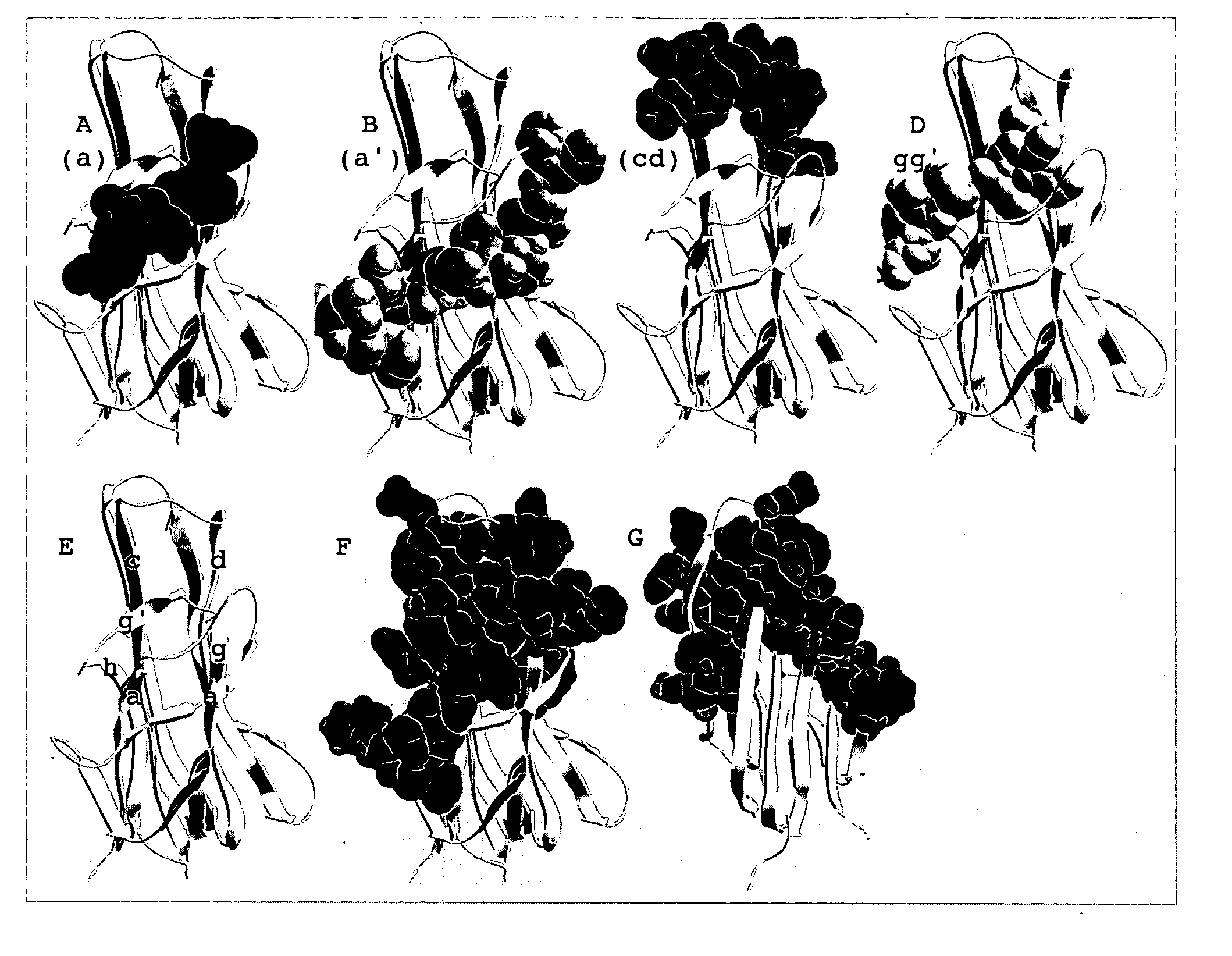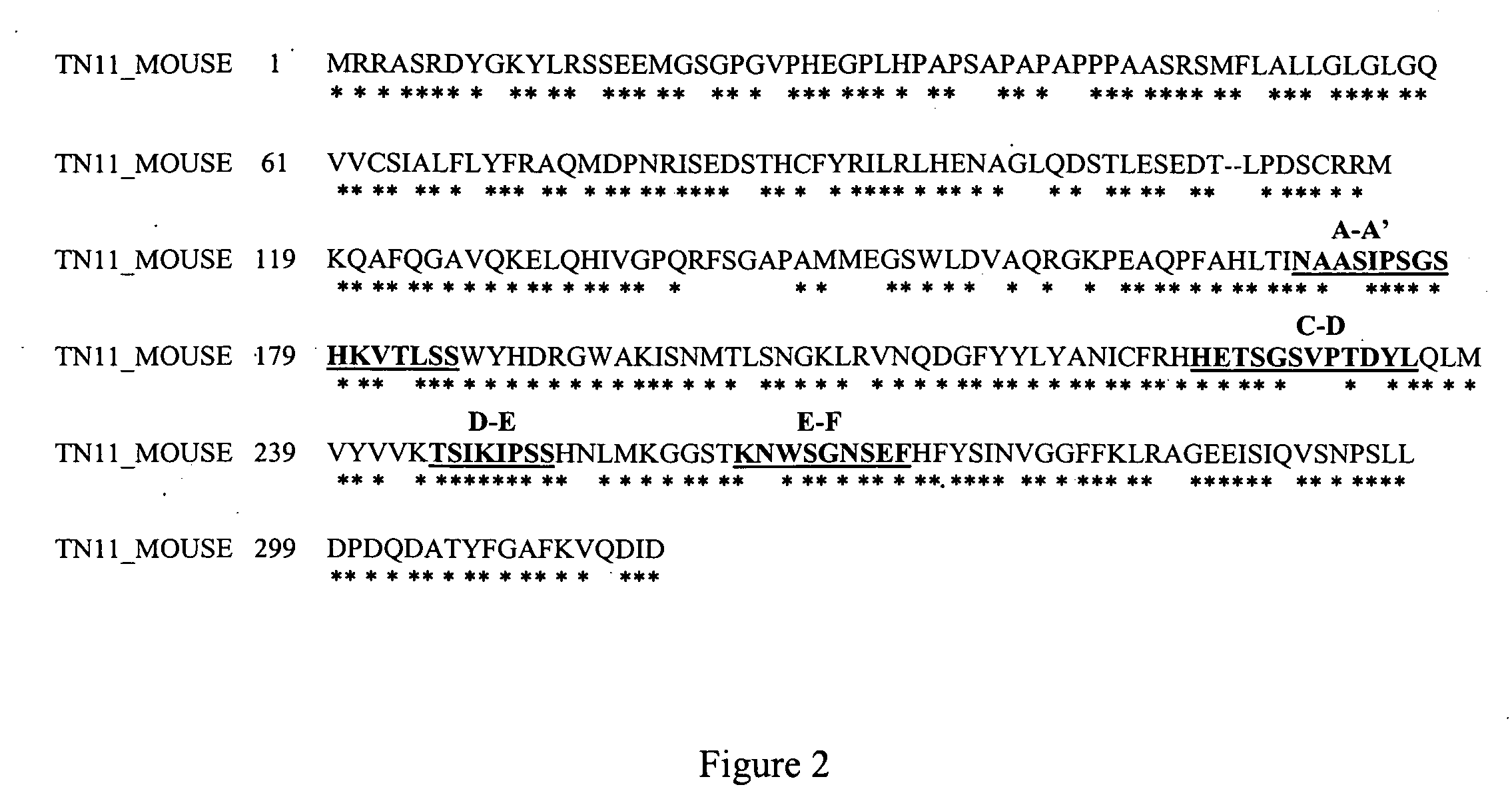Isolation of antibodies that cross-react and neutralize rankl originating from multiple species
- Summary
- Abstract
- Description
- Claims
- Application Information
AI Technical Summary
Benefits of technology
Problems solved by technology
Method used
Image
Examples
example 1
Predicted RANKL Peptide Sequences that Bind to its Receptor
[0775] The mouse RANKL protein is a TNF-related cytokine that regulates osteoclast differentiation and maturation in vitro, and controls bone resorption and remodeling rates in vivo (see Boyle et al., Nature 423, 337-342 [2003] for review). RANKL is a type II surface protein that also exists as a soluble, cleaved form. RANKL mediates these events by the binding of its TNF-like C-terminal domain to the TNFR-related protein, RANK, thereby stimulating osteoclast specific gene expression and cellular differentiation and activation events. In addition to its role in osteoclastiogenesis, RANKL has been reported to induce human dendritic cell (DC) cluster formation, and development of mammary epithelium. Previous studies by Lam et al. (J. Clinical Investigation 108, 971-979 (2001)), and in United States Patent Application Publication Number 20030100068, May 2003, have defined subregions of the RANKL TNF-like domain that are expose...
example 2
Cross-Reactive RANKL Antigens
[0777] The mouse RANKL sequences, and structure / function relationships, shown in Example 1, are highly conserved throughout evolution. Mouse RANKL stimulates osteoclastogenesis from human peripheral blood mononuclear cells (Shalhoub et al., Br. J. Haematol. 111, 501-512 [2000]), as does human RANKL for mouse osteoclast precursors in the spleen and bone marrow (Lacey et al., Cell. 93, 165-76 [1998]). This suggests that the surface loop structures for mouse RANKL are highly conserved, and capable of binding to the RANK receptor from multiple species.
[0778] The RANKL polypeptide sequences available in public databases were aligned using the SIM method, as described by Huang and Miller, “A Time-Efficient, Linear-Space Local Similarity Algorithm”. Advances in Applied Mathematics, vol. 12 (1991), pp. 337-357, and the corresponding loop regions of RANKL were deduced. Shown in FIG. 3 are the homologous regions of the Mouse (ID: O35235), Rat (ID: Q9ESE2), Canin...
example 3
Generation and Isolation of Monoclonal Antibodies
[0786] The overall strategy for producing site-directed anti-RANKL monoclonal antibodies is outlined in FIG. 8. Recombinantly expressed proteins, peptides, and synthetic peptides, either alone or as conjugates link to carrier proteins as described in Example 2 can be used to generate mouse monoclonal antibodies using standard methods known in the art, including as described by Kohler and Milstein (Kohler and Milstein (1975) Nature 256(5517):495-7) (FIG. 5), each of which is which is incorporated herein by reference in its entirety. Mice would be immunized with antigens, then boosted and their hyperimmune spleen cells used to generate hybridomas following fusion to a myeloma cell line. Upon selection, hybridoma cells would be tested for antibody expression, then cloned and expanded if secreting anti-RANKL binding IgG.
[0787] Alternatively, xenogenic mice containing human Ig locus transgenes as described by Green et al. in “Antigen-spe...
PUM
| Property | Measurement | Unit |
|---|---|---|
| Composition | aaaaa | aaaaa |
| Cytotoxicity | aaaaa | aaaaa |
Abstract
Description
Claims
Application Information
 Login to View More
Login to View More - R&D
- Intellectual Property
- Life Sciences
- Materials
- Tech Scout
- Unparalleled Data Quality
- Higher Quality Content
- 60% Fewer Hallucinations
Browse by: Latest US Patents, China's latest patents, Technical Efficacy Thesaurus, Application Domain, Technology Topic, Popular Technical Reports.
© 2025 PatSnap. All rights reserved.Legal|Privacy policy|Modern Slavery Act Transparency Statement|Sitemap|About US| Contact US: help@patsnap.com



